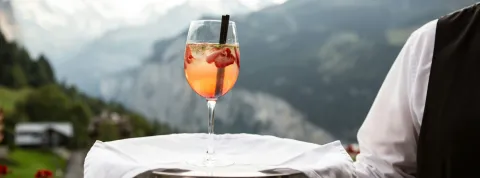
Food and Wine Pairing: The Art of Elevating Luxury Gastronomy
A good pairing can enhance the flavors of both a dish and a wine, thus elevating the experience to new heights. Understanding the principles of food and wine pairing can help create harmonious and memorable gastronomic experiences a particularly essential science in the demanding world of luxury gastronomy. Let yourself be guided through the symphony of flavors, textures, and aromas, and discover how harmony between wine and food can intensify and elevate the senses.
The fundamentals of a successful pairing
Flavor complementarity
The first secret to a successful pairing, or fusion pairing, lies in the quality of the interactions between the flavors. For example, foie gras is perfectly enhanced by a Sauternes, as the sweet richness of the wine harmoniously accompanies the delicate creamy texture. Similarly, roasted turbot with butter will be elevated by a white Burgundy grand cru, whose silky structure prolongs the delicacy of the fish. Here, the wine is no longer just an accompaniment: it becomes a true sensory partner, revealing hidden aromas. The perfect pairing is above all a matter of harmony.
Balanced contrasts
But harmony does not always arise from similarity. Quite often, a carefully controlled contrast of tastes or textures gives rise to surprising harmonies. This is known as an opposition pairing. The iodized crunch of an oyster, for instance, can be exalted by the minerality of a Chablis. The rich melt-in-the-mouth quality of an aged Comté cheese pairs delicately with the fruity flavor of a Vin Jaune from Jura. In these combinations, balance must be carefully maintained, like a kind of dialogue. A wine can thus awaken a dish, surprise the palate, and enhance the tasting experience.
Traditional regional pairings
Terroir pairings, where food and wine share the same geographical origin, are often appreciated because they create a natural and harmonious association. For example, a blanquette de veau will go perfectly with a white wine from Languedoc, and a cassoulet will pair beautifully with a Madiran, a robust and powerful red wine from Gers. The wine and dish, born of the same soil, speak the same language. They share seasons, climates, and a common history.
Haute gastronomy: when pairing becomes creation
The influence of starred chefs
Today, top chefs no longer design their menus without deeply considering food and wine pairings. In Michelin-starred establishments, sommeliers and chefs work hand in hand from the earliest sketches of a dish. A texture, an aroma, or a cooking method may be conceived in response to a specific, sometimes little-known vintage chosen for its character or rarity. This constant dialogue gives rise to combinations of near-choreographic precision. These pairings, envisioned as standalone creations, are the signature of fine dining, where haute cuisine elevates pairing to the level of art.
An emotional and cultural dimension
Beyond taste sensations, a successful pairing also tells a story. It speaks of a terroir, a memory, an intention. When a chef pairs a dish inspired by their childhood with a wine that evokes their first steps in the kitchen, the experience takes on an intimate and cultural dimension. Culinary luxury is no longer just about technical perfection: it becomes a vehicle for emotion. A pairing can evoke the warmth of a summer in Provence, a forgotten family meal, or a trip to Burgundy. In fine dining, this quest for meaning is essential. It transforms the meal into a story, and each bite into a precious moment. Beyond taste, a perfect pairing awakens memory and the senses.
The sommelier: the discreet conductor of the perfect pairing
Client guidance and staging
The sommelier’s role is not limited to reciting a wine list. They observe, ask questions, sometimes even sense unspoken desires. They perceive the occasion whether a business dinner, marriage proposal, or family gathering and adapt their language, tone, and of course, their recommendation. Every bottle becomes a proposal, every service a performance. Their gesture, precise and discreet, contributes as much to the elegance of the setting as to the emotion of the moment. It’s not simply about serving wine, but about revealing an atmosphere, a refinement, a personality. In the world of luxury, the sommelier embodies that extra soul that transforms a meal into an unforgettable memory.
Tasting and tailor-made selection
Behind this ease in the dining room lies the work of a true artisan: selection. A genuine connoisseur of the global vineyard, the sommelier builds their wine cellar like an artist composes a palette. They taste, compare, exchange with winemakers always in search of a rare or unexpected bottle. When collaborating with the chef, they test, adjust, and may even suggest modifying a dish to achieve perfect resonance. This behind-the-scenes work, often invisible to the public, is one of the pillars of excellence in luxury gastronomy. Because at the top, nothing is left to chance!
That is precisely the goal of Sup de Luxe’s MSc Gastronome et Vin. Designed for those who wish to grow in the demanding sectors of haute gastronomy and the world of wine and spirits, this program of excellence offers a complete education blending the culture of taste, international management, brand strategy, and luxury marketing. Through immersive teaching, encounters with renowned professionals, and hands-on experience, students develop global expertise to become future leaders in the international gastronomic scene.
Examples of pairings in haute cuisine
Seafood & mineral white wines
In cuisine, the sea calls for precision. Freshness, salinity, and sometimes nearly raw textures require wines of great finesse. Raw products like oysters and seafood in general demand very dry wines certainly not oaked. Delicate fish with tender flesh, like sole or turbot, pair best with subtle wines such as Chablis from Burgundy or Vouvray from the Loire. Fish with stronger flavors like sea bream or bass go well with more mineral wines, like those from Corsica or Provence, which mirror the iodine notes of the sea.
Game & bold reds
When dishes increase in intensity, such as game (doe, venison, wild boar, rabbit…), the wines must rise to the occasion. Bold red wines, rich in tannins, aged in barrels, sometimes softened with age, are ideal. An aged Pauillac, a Châteauneuf-du-Pape with animal notes, or a structured Tuscan wine all find perfect expression here. These pairings tell a story of depth, substance, and terroir. In fine dining, they embody a kind of elevated tradition where strength is always tempered by mastery of cooking and vintage selection.
Dessert & champagne or sweet wines
The sweet course, long overlooked in pairings, is now enjoying a comeback. Starred pastry chefs are creating desserts that pair just as well with an extra-brut champagne as with a well-balanced sweet wine. A delicate apricot tart can be enjoyed with a rosé champagne featuring red fruit notes, while a dark chocolate sphere pairs perfectly with an aged Port or a natural sweet wine from Roussillon. But be careful not to overload the end of the meal with too much sugar favor wines that are sweet but acidic.
Don’t forget that food and wine pairings are always subjective, and there are no rigid rules. The most important thing is to trust your palate and experiment with different combinations to find what suits you best. And above all, remember that the best pairings are often the most unexpected!
